Environmental Life Cycle Assessment of Class A Biosolids Production Using Conventional and Low-Cost, Low-Tech Processes at Small Water Resource Recovery Facilities
Abstract
1. Introduction
2. Methodology
2.1. Goal, Scope, Functional Unit, and Process Selection
2.2. Life Cycle Input and Output Data for Each Biosolids Production Process
2.2.1. Air Drying
2.2.2. Lagoon Storage
2.2.3. Composting
2.2.4. Direct Heat Drying
2.2.5. TPAD
2.3. Impact Assessment
3. Results and Discussion
3.1. Air Drying Results
Sensitivity Analysis—Biogenic Emissions
3.2. Lagoon Storage Results
3.3. Composting Results
3.4. Direct Heat Drying Results
3.5. TPAD Results
3.6. Transportation Sensitivity Analysis
3.7. Greenhouse Gas Emissions Comparison
4. Conclusions
Supplementary Materials
Author Contributions
Funding
Institutional Review Board Statement
Informed Consent Statement
Data Availability Statement
Conflicts of Interest
References
- Elgarahy, A.M.; Eloffy, M.; Priya, A.; Yogeshwaran, V.; Yang, Z.; Elwakeel, K.Z.; Lopez-Maldonado, E.A. Biosolids management and utilizations: A review. J. Clean. Prod. 2024, 451, 141974. [Google Scholar]
- Beecher, N.; Beecher, J.; Burke-Wells, J.; Lono-Batura, M.; Goldstein, N.; Kester, G.; Toffey, W. National Biosolids Data Project: Biosolids management in the U. S. 2022. Available online: https://www.biosolidsdata.org (accessed on 18 March 2025).
- NEBRA. Options for Biosolids Use or Disposal in New England & Eastern Canada; North East Biosolids and Residuals Association: Hope, RI, USA, 2011. [Google Scholar]
- U.S. EPA. 40 CFR Part 503, Standards for the Use or Disposal of Sewage Sludge. Fed. Regist. 1993, 58, 9248–9387. [Google Scholar]
- U.S. EPA. Small Wastewater Systems Research. 2024. Available online: https://www.epa.gov/water-research/small-wastewater-systems-research (accessed on 15 September 2024).
- Becker, J.G.; Seagren, E.A. A Blueprint for High-Tech Analysis of Low-Tech Methods for Sustainable Class A Biosolids Production: Phase 1; The Water Environment & Reuse Foundation: Alexandria, VA, USA, 2017; 42p. [Google Scholar]
- Becker, J.G.; Seagren, E.A. High-Tech Analysis of Low-Tech Methods for Sustainable Class A Biosolids Production: Phase 2; The Water Research Foundation: Alexandria, VA, USA; Denver, CO, USA, 2019; 48p. [Google Scholar]
- Farrell, J.B.; Merrill, D.; Schafer, P. Producing Class A Biosolids with Low-Cost, Low-Technology Treatment Processes; Water Environment Research Foundation (WERF) Report 95-REM-2; IWA Publishing: London, UK, 2004. [Google Scholar]
- ISO 14040:2006; Environmental Management—Life Cycle Assessment—Principles and Framework. International Organization for Standardization (ISO): Geneva, Switzerland, 2006. Available online: https://www.iso.org/standard/37456.html (accessed on 10 October 2023).
- Nabaterega, R.; Kumar, V.; Khoei, S.; Eskicioglu, C. A review on two-stage anaerobic digestion options for optimizing municipal wastewater sludge treatment process. J. Environ. Chem. Eng. 2021, 9, 105502. [Google Scholar]
- Metcalf and Eddy. Wastewater Engineering: Treatment and Resource Recovery; McGraw-Hill Education: Boston, MA, USA, 2014. [Google Scholar]
- MWRD. Metropolitan Water Reclamation District of Greater Chicago (MWRD), Report No. 20-28: Annual Biosolids Management Report for 2019. 2020. Available online: https://mwrd.org/sites/default/files/documents/20-28%20Annual%20Biosolids%20Management%20Report%20for%202019.pdf (accessed on 15 December 2024).
- Wernet, G.; Bauer, C.; Steubing, B.; Reinhard, J.; Moreno-Ruiz, E.; Weidema, B. The ecoinvent database version 3 (part I): Overview and methodology. Int. J. Life Cycle Assess. 2016, 21, 1218–1230. [Google Scholar]
- U.S. EPA. Emissions and Generation Resource Integrated Database (eGRID); U.S. Environmental Protection Agency (U.S. EPA): Washington, DC, USA, 2023. Available online: https://www.epa.gov/egrid (accessed on 10 October 2023).
- Hospido, A.; Moreira, T.; Martín, M.; Rigola, M.; Feijoo, G. Environmental Evaluation of Different Treatment Processes for Sludge from Urban Wastewater Treatments: Anaerobic Digestion versus Thermal Processes. Int. J. Life Cycle Assess. 2005, 10, 336–345. [Google Scholar] [CrossRef]
- Shammas, N.K.; Wang, L.K. Belt Filter Presses. In Biosolids Treatment Processes; Springer: Berlin/Heidelberg, Germany, 2007; pp. 519–539. Available online: https://link.springer.com/chapter/10.1007/978-1-59259-996-7_17 (accessed on 15 September 2024).
- Komilis, D.P.; Ham, R.K. Life-Cycle Inventory of Municipal Solid Waste and Yard Waste Windrow Composting in the United States. J. Environ. Eng. 2004, 130, 1390–1400. [Google Scholar] [CrossRef]
- Li, Z.; Zhang, K.; Pang, K.; Di, B. A fuel-based approach for emission factor development for highway paving construction equipment in China. J. Air Waste Manag. Assoc. 2016, 66, 1214–1223. [Google Scholar] [PubMed]
- SCAP. California Biosolids Use and Disposal in 2015. Southern California Alliance of Publicly Owned Treatment Works. 2016. Available online: https://cleanwatersocal.org/media/acfupload/reference/California_Biosolids_Use_and_Disposal_for_2015.pdf (accessed on 10 July 2024).
- Yamulki, S. Effect of straw addition on nitrous oxide and methane emissions from stored farmyard manures. Agric. Ecosyst. Environ. 2006, 112, 140–145. [Google Scholar] [CrossRef]
- Rynk, R.; Van de Kamp, M.; Willson, G.B.; Singley, M.E.; Richard, T.L.; Kolega, J.J.; Gouin, F.R.; Laliberty, L.; Kay, D.; Murphy, D.; et al. On-Farm Composting Handbook (NRAES 54). Northeast Regional Agricultural Engineering Service (NRAES). 1992. Available online: https://ecommons.cornell.edu/items/c66de614-e524-46a3-a4cb-031c9a1e7e11 (accessed on 3 September 2024).
- Nordahl, S.L.; Preble, C.V.; Kirchstetter, T.W.; Scown, C.D. Greenhouse gas and air pollutant emissions from composting. Environ. Sci. Technol. 2023, 57, 2235–2247. [Google Scholar] [CrossRef] [PubMed]
- Majumder, R.; Livesley, S.J.; Gregory, D.; Arndt, S.K. Biosolid stockpiles are a significant point source for greenhouse gas emissions. J. Environ. Manag. 2014, 143, 34–43. [Google Scholar] [CrossRef] [PubMed]
- Spellman, F.R. Wastewater Biosolids to Compost; Technomic Publishing Company: Lancaster, PA, USA, 1997. [Google Scholar]
- Shammas, N.K.; Wang, L.K. Biosolids Composting. In Biosolids Treatment Processes; Springer: Berlin/Heidelberg, Germany, 2007; pp. 645–687. Available online: https://link.springer.com/chapter/10.1007/978-1-59259-996-7_21 (accessed on 15 September 2024).
- Poulsen, T.G.; Hansen, J.A. Strategic environmental assessment of alternative sewage sludge management scenarios. Waste Manag. Res. J. Sustain. Circ. Econ. 2003, 21, 19–28. [Google Scholar]
- Brown, S.; Kruger, C.; Subler, S. Greenhouse Gas Balance for Composting Operations. J. Environ. Qual. 2008, 37, 1396–1410. [Google Scholar] [CrossRef] [PubMed]
- Roy, D.; Benkaraache, S.; Azaïs, A.; Drogui, P.; Tyagi, R.D. Leachate treatment: Assessment of the systemic changes in the composition and biodegradability of leachates originating in an open co-composting facility in Canada. J. Environ. Chem. Eng. 2019, 7, 103056. [Google Scholar] [CrossRef]
- U.S. EPA. Biosolids Technology Fact Sheet: Heat Drying; U.S. Environmental Protection Agency (U.S. EPA): Washington, DC, USA, 2006. Available online: https://www.epa.gov/sites/production/files/2018-11/documents/heat-drying-factsheet.pdf (accessed on 10 October 2023).
- ANL. Greenhouse Gases, Regulated Emissions, and Energy Use in Transportation (GREET) Model; Argonne National Laboratory, Energy Systems Division: DuPage County, IL, USA, 2018. [Google Scholar]
- Jolliet, O.; Margni, M.; Charles, R.; Humbert, S.; Payet, J.; Rebitzer, G.; Rosenbaum, R. IMPACT 2002+: A New Life Cycle Impact Assessment Methodology. Int. J. Life Cycle Assess. 2003, 8, 324–330. [Google Scholar] [CrossRef]
- IPCC. Climate Change 2013: The Physical Science Basis. Contribution of Working Group I to the Fifth Assessment Report of the Intergovernmental Panel on Climate Change; Stocker, T.F., Qin, D., Plattner, G.-K., Tignor, M., Allen, S.K., Boschung, J., Nauels, A., Xia, Y., Bex, V., Midgley, P.M., Eds.; Cambridge University Press: Cambridge, UK; New York, NY, USA, 2013; p. 1535. [Google Scholar]
- WEF. Drying of Wastewater Biosolids Fact Sheet; Water Environment Federation Residuals and Biosolids Committee Bioenergy Technology Subcommittee; Water Environment Federation (WEF): Alexandria, VA, USA, 2014; Available online: http://www.wrrfdata.org/NBP/DryerFS/Drying_of_Wastewater_Solids_Fact_Sheet_January2014.pdf (accessed on 1 September 2024).
- SYLVIS. The Biosolids Emissions Assessment Model (BEAM): A Method for Determining Greenhouse Gas Emissions from Canadian Biosolids Management Practices. Winnipeg, Manitoba, Canadian Council of Ministers of the Environment. 2009. Available online: http://faculty.washington.edu/slb/docs/CCME_final_report.pdf (accessed on 10 October 2023).
- Cornejo, P.K.; Becker, J.; Pagilla, K.; Mo, W.; Zhang, Q.; Mihelcic, J.R.; Chandran, K.; Sturm, B.; Yeh, D.; Rosso, D. Sustainability metrics for assessing water resource recovery facilities of the future. Water Environ. Res. 2019, 91, 45–53. [Google Scholar] [PubMed]
- Pfeffer, K.; Porter, J.; Lisk, B.; Bullard, M.; Guzman, K.; Chiavaroli, M. Selecting an Advanced Anaerobic Digestion Configuration and Biogas Management Strategy for the City of Tampa. Proc. Water Environ. Fed. 2019, 2018, 688–714. [Google Scholar] [CrossRef]
- CAPA. Asphalt Tonnage Calculator. 2019. Available online: https://co-asphalt.com/resources/asphalt-tonnage-calculator/ (accessed on 6 May 2019).
- Caterpiller. 924K, 930K, 938K Wheel Loaders. 2012. Available online: https://s7d2.scene7.com/is/content/Caterpillar/C737355 (accessed on 6 May 2019).
- Harris, R.A.; Phillips, D.R. Density of Selected Wood Fuels; Georgia Forest Research Paper; Georgia Forestry Commission: Macon, GA, USA, 1986. [Google Scholar]
- Jackson, T. The Owning and Operating Costs of Dump Trucks. 2010. Available online: https://www.equipmentworld.com/owning-and-operating-costs-8/ (accessed on 6 May 2019).
- Myhre, G.; Shindell, D.; Bréon, F.-M.; Collins, W.; Fuglestvedt, J.; Huang, J.; Koch, D.; Lamarque, J.-F.; Lee, D.; Mendoza, B.; et al. Chapter 8: Anthropogenic and Natural Radiative Forcing. In Climate Change 2013: The Physical Science Basis. Contribution of Working Group I to the Fifth Assessment Report of the Intergovernmental Panel on Climate Change; Intergovernmental Panel on Climate Change: Cambridge, UK, 2013. [Google Scholar]
- Puchajda, B.; Oleszkiewicz, J. Impact of sludge thickening on energy recovery from anaerobic digestion. Water Sci. Technol. 2008, 57, 395–401. [Google Scholar] [CrossRef] [PubMed]
- Riau, V.; De la Rubia, M.Á.; Pérez, M. Temperature-Phased Anaerobic Digestion (TPAD) to Obtain Class A Biosolids: A Semi-Continuous Study. Bioresour. Technol. 2010, 101, 2706–27112. [Google Scholar] [PubMed]
- Suh, Y.-J.; Rousseaux, P. An LCA of Alternative Wastewater Sludge Treatment Scenarios. Resour. Conserv. Recycl. 2002, 35, 191–200. [Google Scholar] [CrossRef]
- Tiquia, S.M.; Richard, T.L.; Honeyman, M.S. Carbon, nutrient, and mass loss during Composting. Nutr. Cycl. Agroecosyst. 2002, 62, 15–24. [Google Scholar] [CrossRef]
- U.S. EPA. Biosolids Technology Fact Sheet: Multi-Stage Anaerobic Digestion; Environmental Protection Agency: Washington, DC, USA, 2006. Available online: https://www.epa.gov/biosolids/fact-sheet-multi-stage-anaerobic-digestion (accessed on 10 October 2023).
- Wang, L.K.; Shammas, N.K.; Hung, Y.T. Biosolids Treatment Processes; Humana Press: Totowa, NJ, USA, 2007. [Google Scholar]
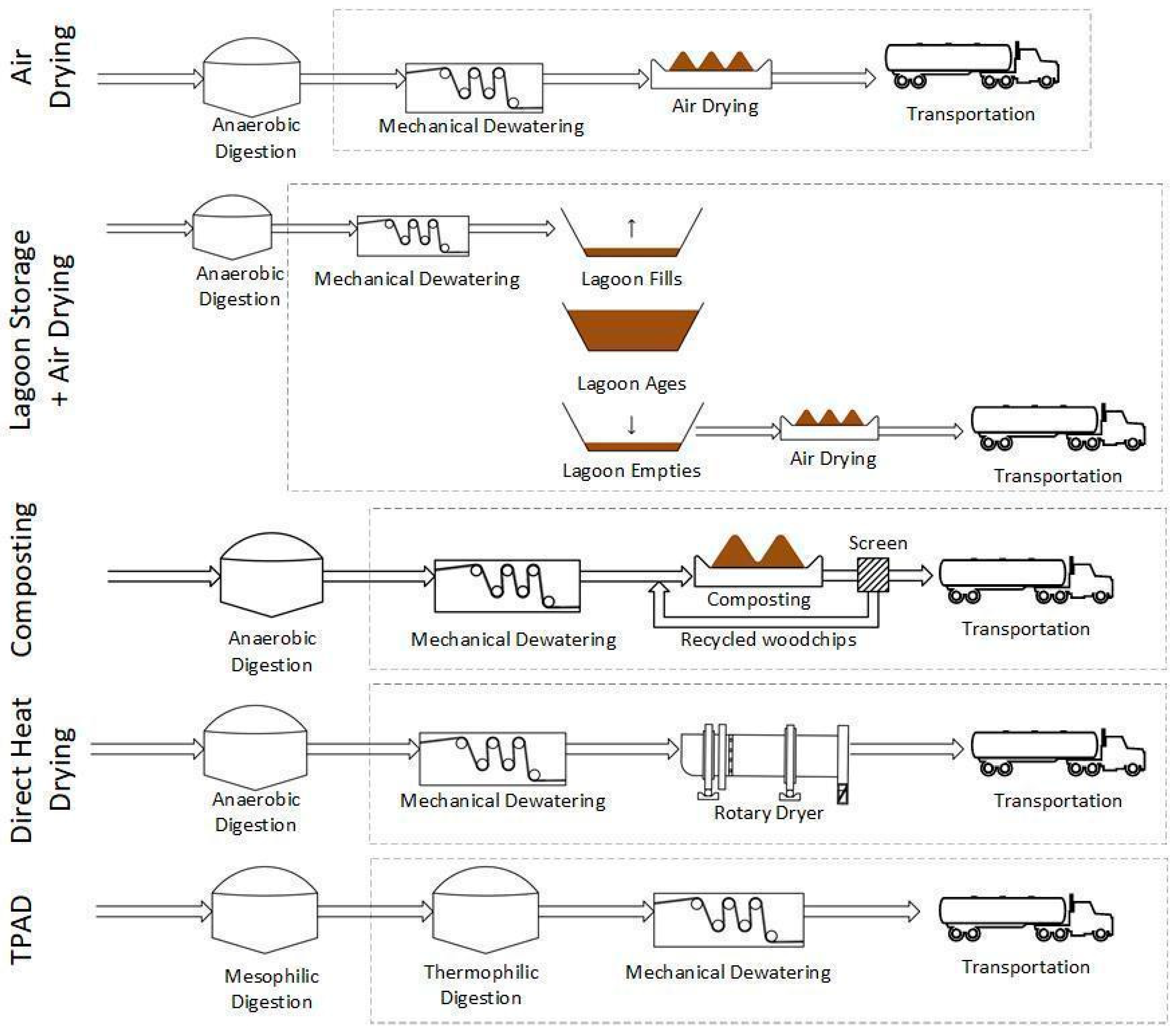
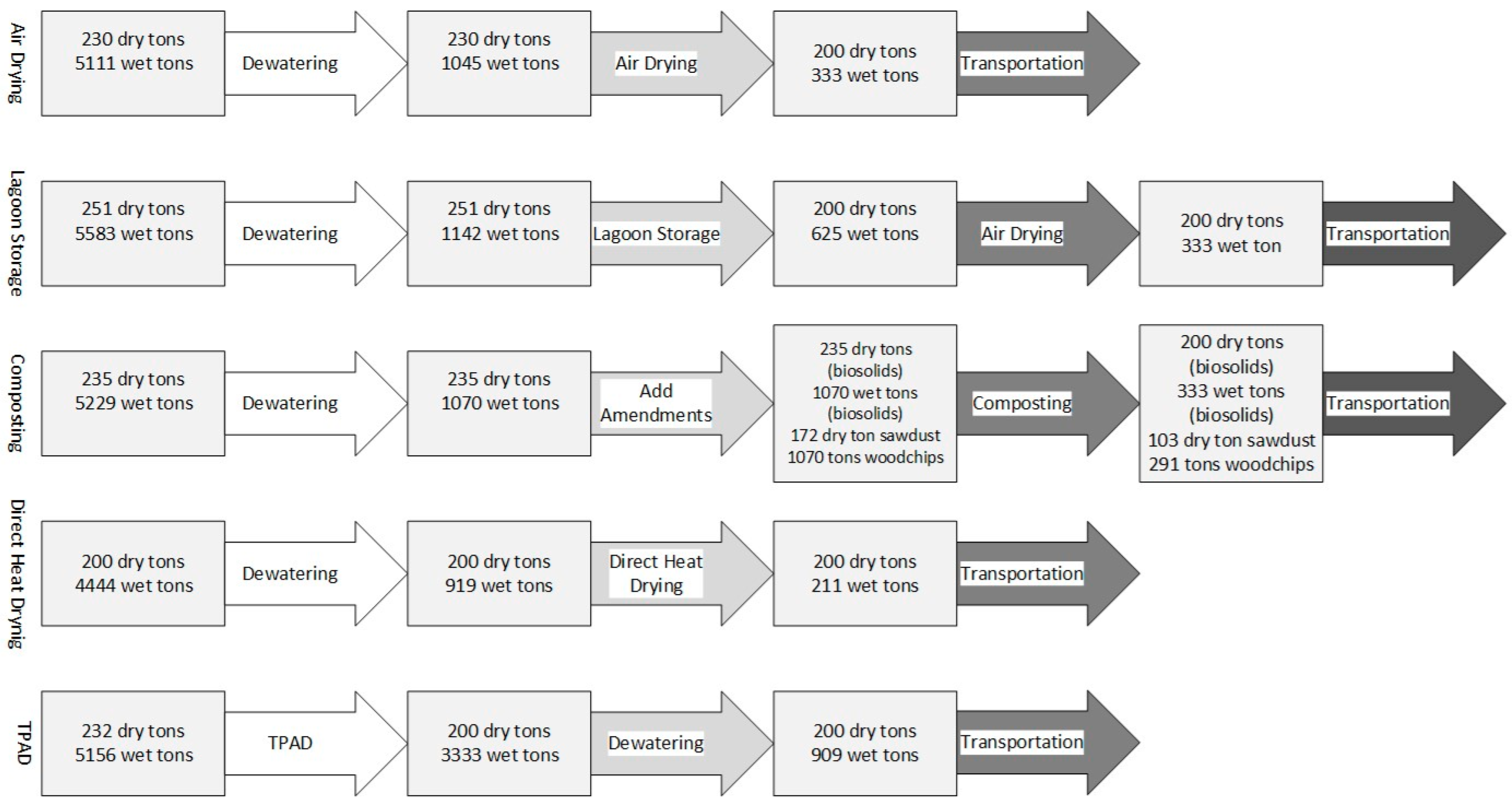
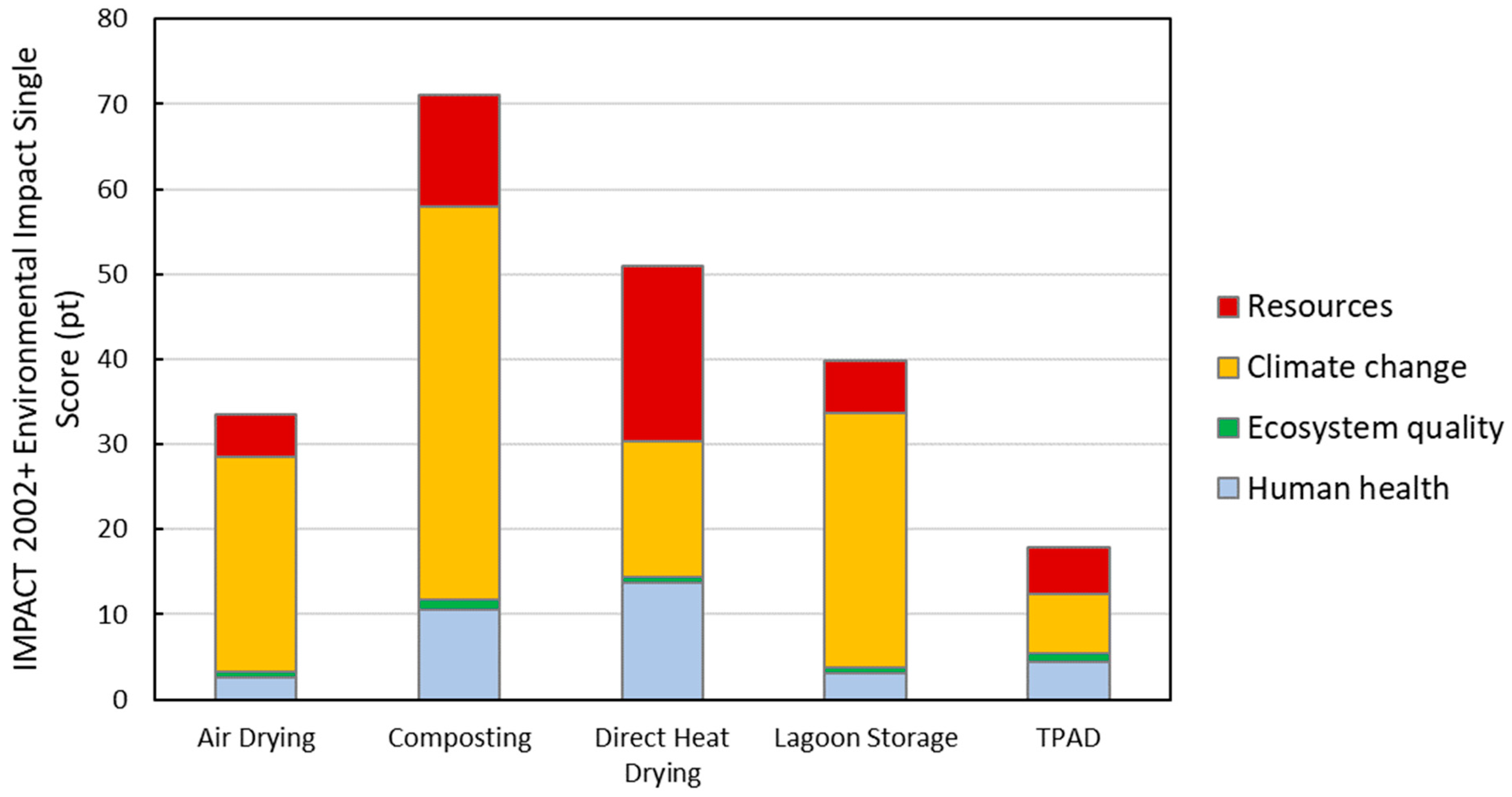
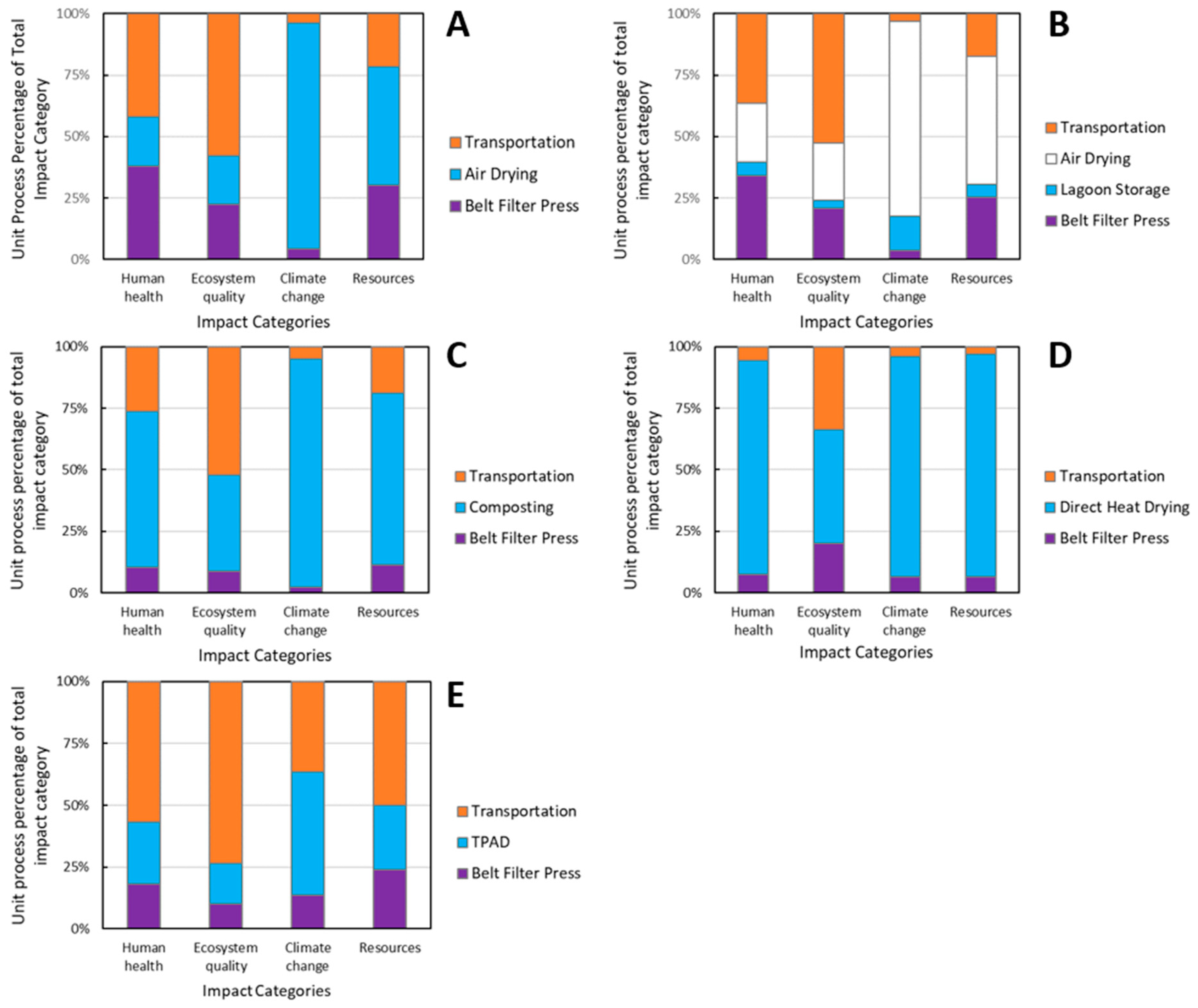
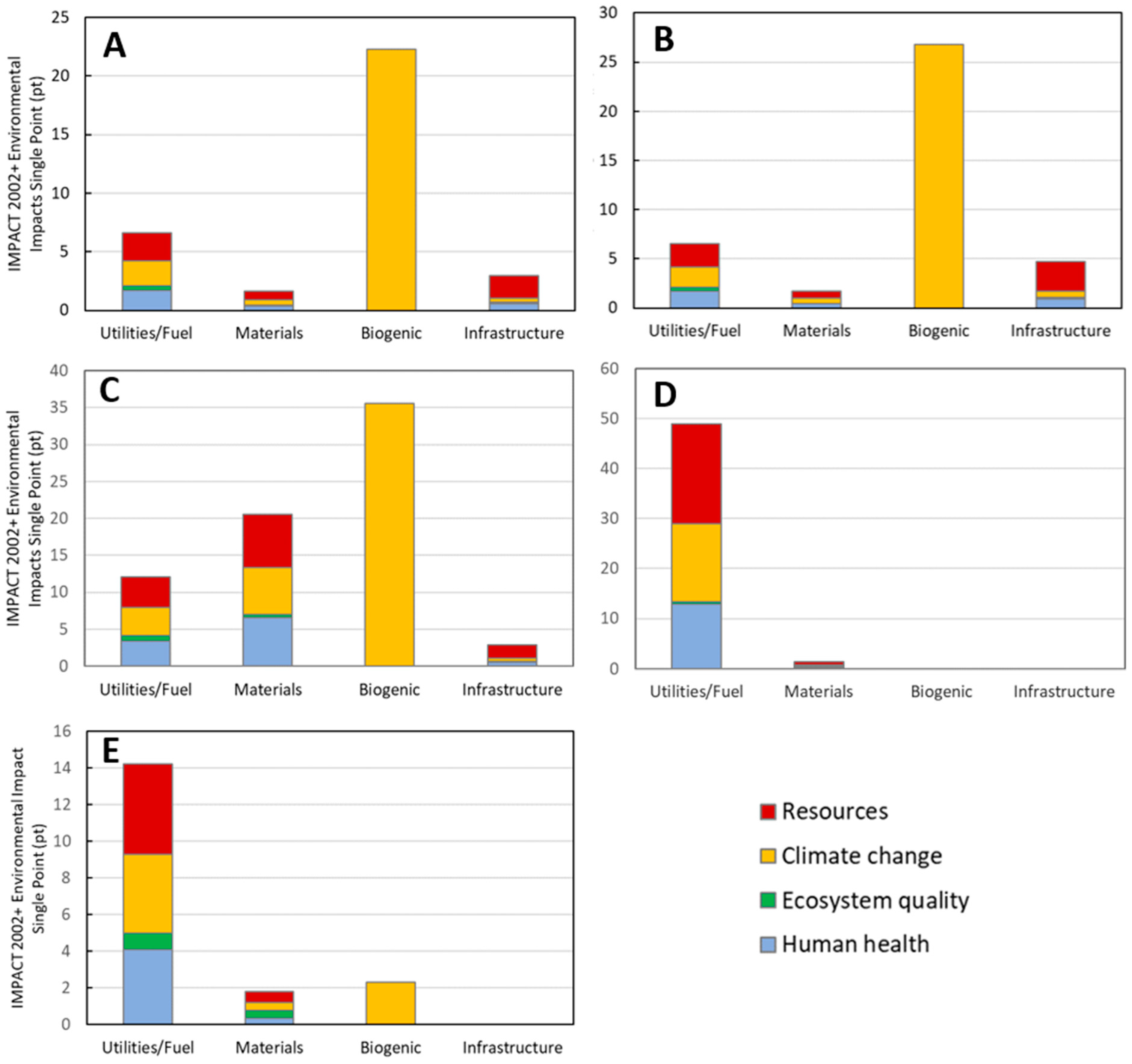
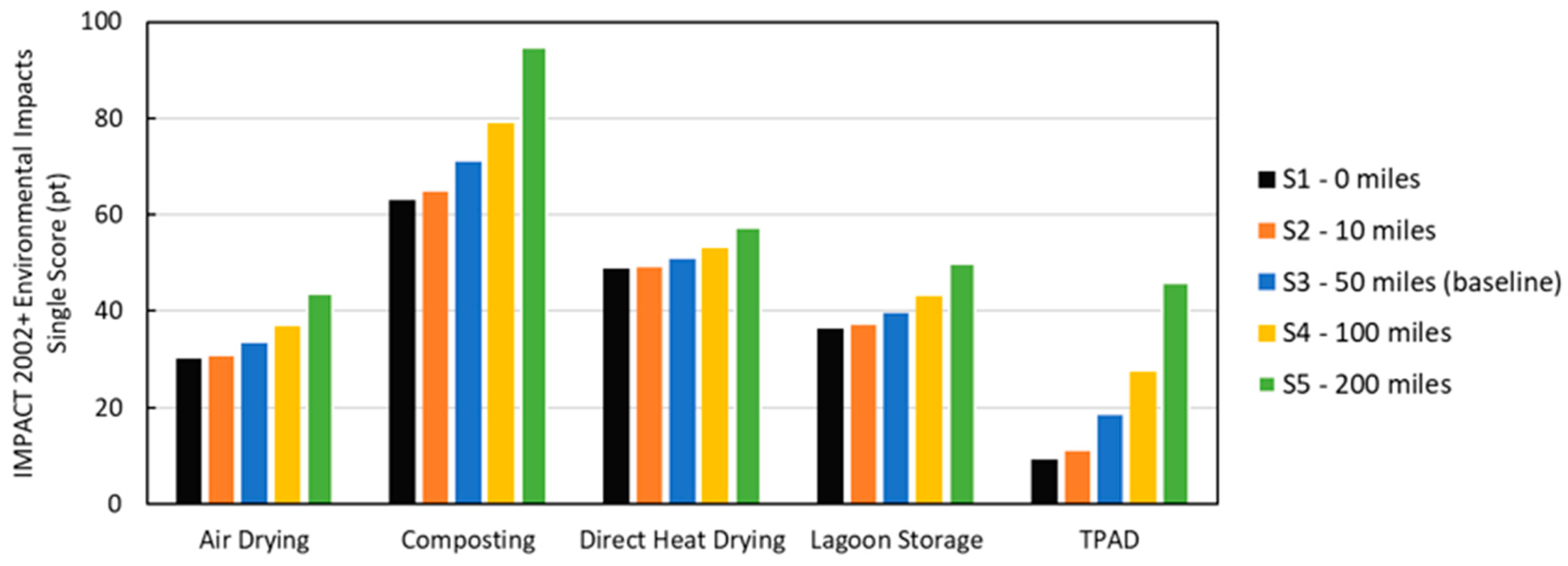
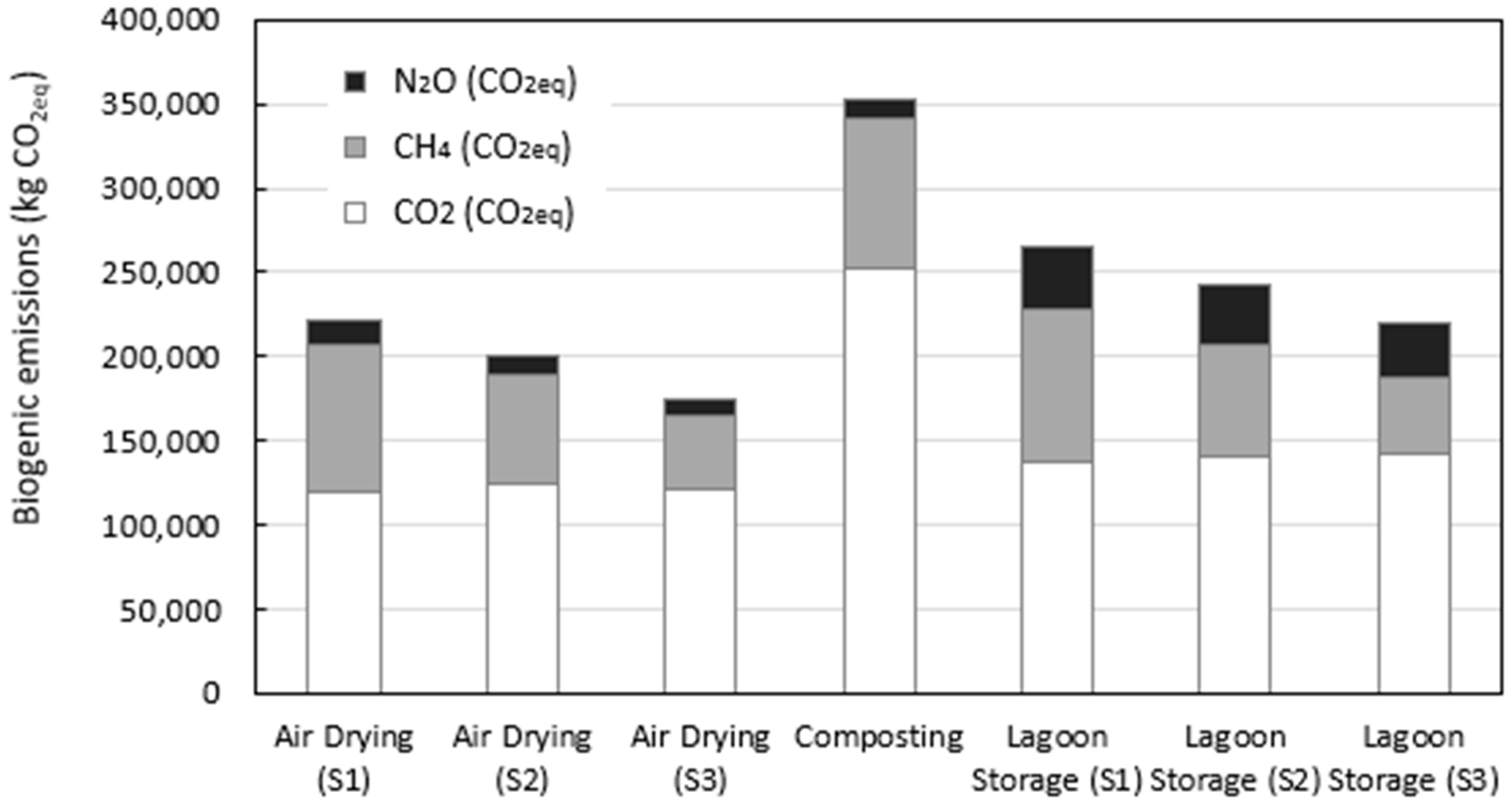
| Parameter | Value | Unit | Ecoinvent Item/Comments |
|---|---|---|---|
| Inputs | |||
| Dewatering Electricity | 20,895 | kWh | US electricity, medium voltage, at grid, updated grid mix |
| Dewatering Polymer | 1252 | kg | Acrylonitrile, market |
| Dewatering Water | 2490 | kg | Tap water, at user |
| Wastewater to be Treated | 3437 | kg | Treatment, sewage, unpolluted, to wastewater treatment, class 3 |
| Diesel Fuel | 610 | kg | Diesel, at regional storage |
| Asphalt | 54,122 | kg | Asphalt a |
| Transportation of Final Product | 48,664 | tkm | Transport, lorry 16-32t, EURO3 |
| Outputs | |||
| CO2, Biogenic | 119,619 | kg | Carbon dioxide |
| CH4, Biogenic | 3107 | kg | Methane |
| N2O, Biogenic | 54 | kg | Nitrous oxide |
| CO2, Fuel Combustion | 4270 | kg | Carbon dioxide |
| Scenario | Methane Emissions | Nitrous Oxide Emissions |
|---|---|---|
| Scenario 1—Most conservative and highest emissions | 3.8% of initial carbon | 0.87% of initial nitrogen |
| Scenario 2—Intermediate emissions | 2.85% of initial carbon | 0.74% of initial nitrogen |
| Scenario 3—Least emissions (Composting-like conditions) | 1.9% of initial carbon | 0.60% of initial nitrogen |
| Parameter | Value | Unit | Ecoinvent Item/Comments |
|---|---|---|---|
| Inputs | |||
| Dewatering electricity | 20,895 | kWh | Electricity, medium voltage, at grid |
| Dewatering polymer | 1368 | kg | Acrylonitrile, market |
| Dewatering water | 2496 | kg | Tap water, at user |
| Wastewater to be treated | 3531 | kg | Treatment, sewage, unpolluted, at wastewater treatment, class 3 |
| Diesel fuel | 528 | kg | Diesel, at regional storage |
| Clay | 54,244 | kg | Clay, market |
| HPDE liner | 230 | kg | HDPE resin E |
| Asphalt | 53,150 | kg | Asphalt a |
| Transportation of biosolids | 48,664 | tkm | Transport, lorry 16–32 t, EURO3 |
| Outputs | |||
| CO2, biogenic | 207,370 | kg | Carbon dioxide |
| CH4, biogenic | 1926 | kg | Methane |
| N2O, biogenic | 885 | kg | Nitrous oxide |
| CO2, fuel combustion | 3720 | kg | Carbon dioxide |
| Parameter | Value | Unit | Ecoinvent Item/Comments |
|---|---|---|---|
| Inputs | |||
| Dewatering electricity | 20,895 | kWh | Electricity, medium voltage, at grid |
| Dewatering polymer | 1281 | kg | Acrylonitrile, market for |
| Dewatering water | 2492 | kg | Tap water, at user |
| Wastewater to be treated | 3460 | kg | Treatment, sewage, unpolluted, at to wastewater treatment, class 3 |
| Woodchips | 488,564 | kg | Waste woodchips, mixed, from industry, u = 40%, at plant |
| Sawdust | 238,654 | kg | Sawdust, from dried lumber, at planer mill, US PNW/kg |
| Diesel fuel | 1486 | kg | Diesel, at regional storage |
| Trommel screen electricity | 1169 | kWh | Electricity, medium voltage, at grid |
| Asphalt | 52,184 | kg | Asphalt a |
| Transportation of final product | 141,286 | tkm | Transport, lorry 16–32 t, EURO3 |
| Outputs | |||
| CO2, biogenic | 146,611 | kg | Carbon dioxide |
| CH4, biogenic | 1838 | kg | Methane |
| N2O, biogenic | 23 | kg | Nitrous oxide |
| CO2, fuel combustion | 10,486 | kg | Carbon dioxide |
| Parameter | Value | Unit | Ecoinvent Name |
|---|---|---|---|
| Inputs | |||
| Dewatering Electricity | 20,895 | kWh | Electricity, medium voltage, at grid |
| Dewatering Polymer | 1089 | kg | Acrylonitrile, market |
| Dewatering Water | 2482 | kg | Tap water, at user |
| Wastewater to be Treated | 3305 | kg | Treatment, sewage, unpolluted, to wastewater treatment, class 3 |
| Natural Gas | 62,062 | m3 | Natural gas, combusted in industrial boiler |
| Transportation of Final Product | 30,735 | tkm | Transport, lorry 16–32 t, EURO3 |
| Parameter | Value | Unit | Ecoinvent Name |
|---|---|---|---|
| Inputs | |||
| Dewatering Electricity | 20,895 | kWh | Electricity, medium voltage, at grid |
| Dewatering Polymer | 1089 | kg | Acrylonitrile, market |
| Dewatering Water | 2482 | kg | Tap water, at user |
| Wastewater to be Treated | 3046 | kg | Treatment, sewage, unpolluted, at wastewater treatment, class 3 |
| TPAD Electricity | 17,401 | kWh | Electricity, medium voltage, at grid |
| Transportation of Final Product | 132,719 | tkm | Transport, lorry 16–32 t, EURO3 |
| Outputs | |||
| Carbon Dioxide | 22,976 | kg | Carbon dioxide |
Disclaimer/Publisher’s Note: The statements, opinions and data contained in all publications are solely those of the individual author(s) and contributor(s) and not of MDPI and/or the editor(s). MDPI and/or the editor(s) disclaim responsibility for any injury to people or property resulting from any ideas, methods, instructions or products referred to in the content. |
© 2025 by the authors. Licensee MDPI, Basel, Switzerland. This article is an open access article distributed under the terms and conditions of the Creative Commons Attribution (CC BY) license (https://creativecommons.org/licenses/by/4.0/).
Share and Cite
Brown, J.L.; Handler, R.M.; Becker, J.G.; Seagren, E.A. Environmental Life Cycle Assessment of Class A Biosolids Production Using Conventional and Low-Cost, Low-Tech Processes at Small Water Resource Recovery Facilities. Appl. Sci. 2025, 15, 3482. https://doi.org/10.3390/app15073482
Brown JL, Handler RM, Becker JG, Seagren EA. Environmental Life Cycle Assessment of Class A Biosolids Production Using Conventional and Low-Cost, Low-Tech Processes at Small Water Resource Recovery Facilities. Applied Sciences. 2025; 15(7):3482. https://doi.org/10.3390/app15073482
Chicago/Turabian StyleBrown, Janna L., Robert M. Handler, Jennifer G. Becker, and Eric A. Seagren. 2025. "Environmental Life Cycle Assessment of Class A Biosolids Production Using Conventional and Low-Cost, Low-Tech Processes at Small Water Resource Recovery Facilities" Applied Sciences 15, no. 7: 3482. https://doi.org/10.3390/app15073482
APA StyleBrown, J. L., Handler, R. M., Becker, J. G., & Seagren, E. A. (2025). Environmental Life Cycle Assessment of Class A Biosolids Production Using Conventional and Low-Cost, Low-Tech Processes at Small Water Resource Recovery Facilities. Applied Sciences, 15(7), 3482. https://doi.org/10.3390/app15073482






